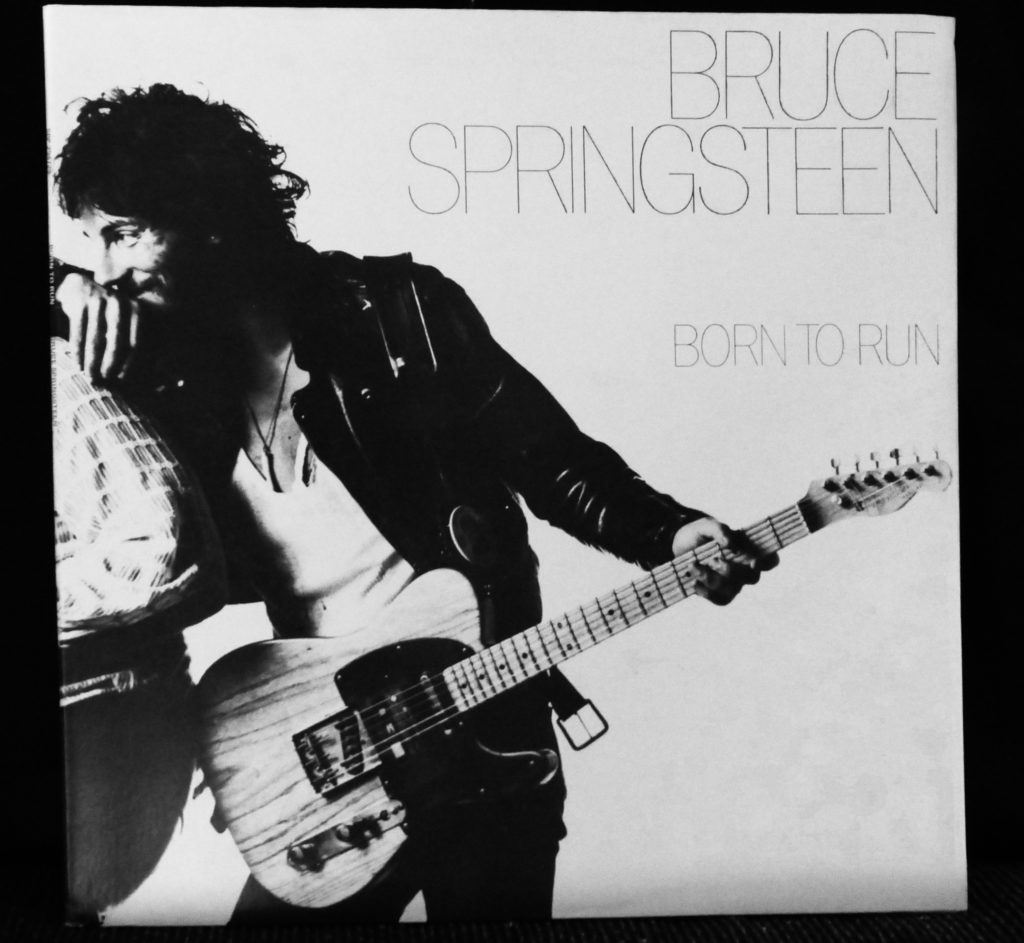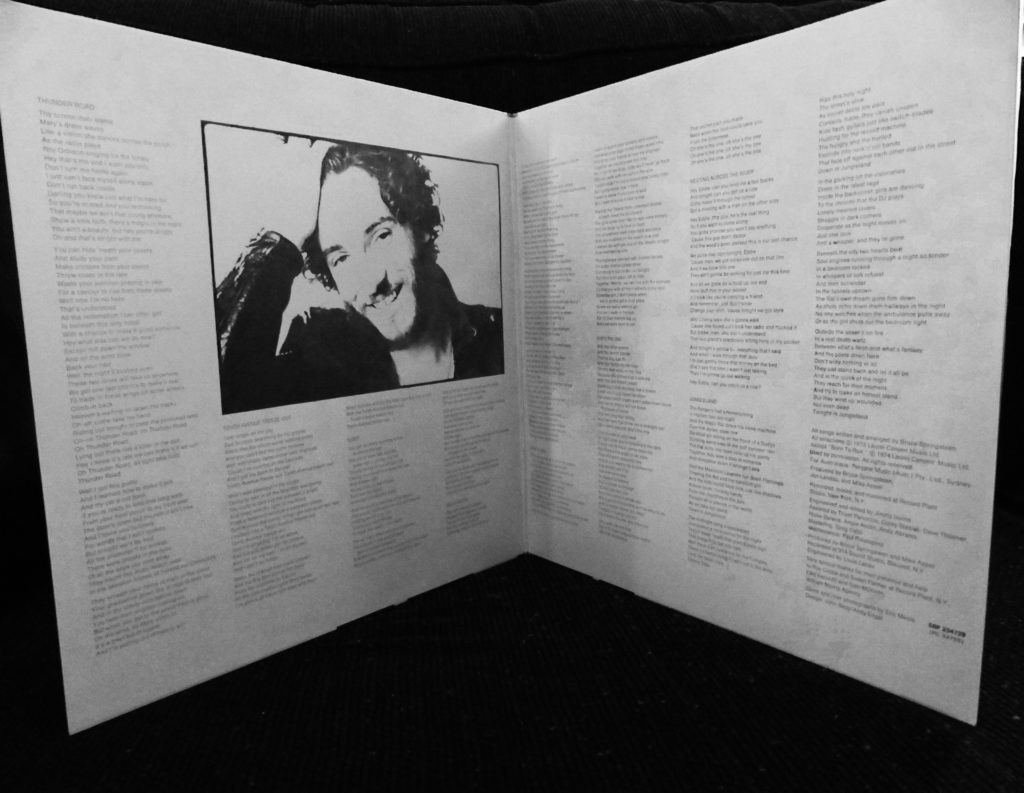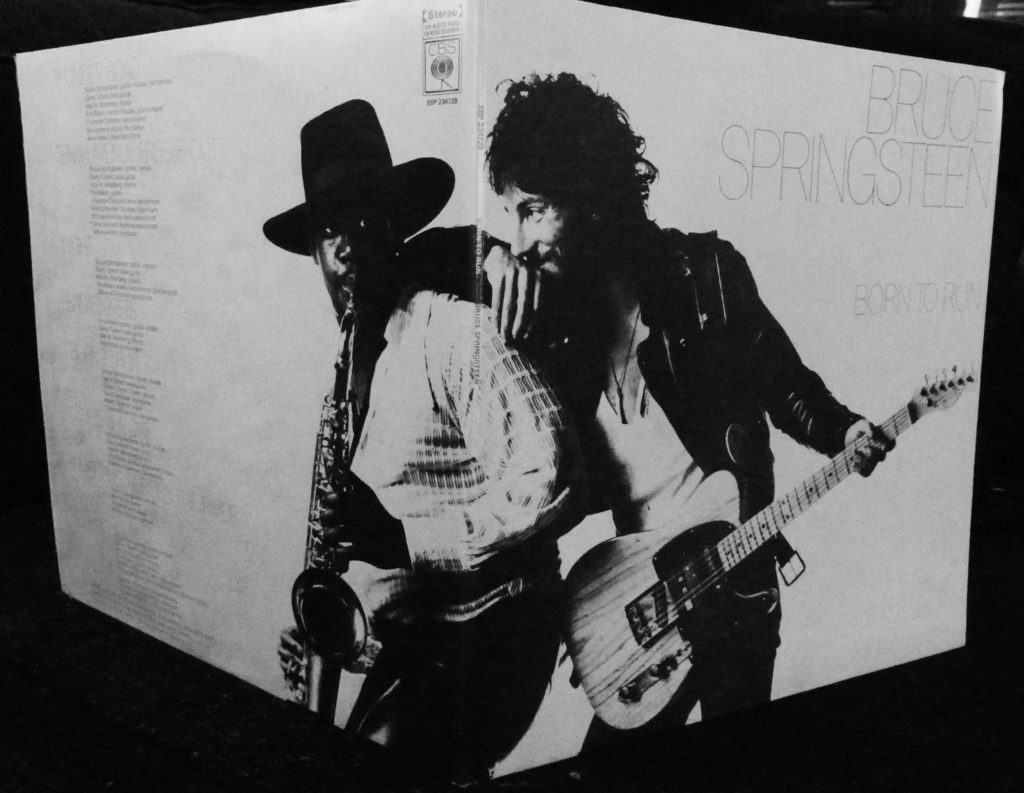
“I saw rock and roll future and its name is Bruce Springsteen”. It’s a hell of a claim and while that quote may not have accurately predicted what was to come it certainly became part of rock mythology. The man who wrote it was John Landau, the music critic and record producer who would go on to both produce and manage Springsteen. It was written as part of a review for a live gig when Springsteen was struggling in his career after his first 2 albums had sold poorly with mounting pressure from his record company (CBS) to deliver a hit record. It’s also a quote that would become an albatross around the neck of Springsteen as his record company later zealously used it to market him and his music.
Born To Run had a lengthy and difficult birth with Springsteen painstakingly writing and rewriting the album’s lyrics many times while wrestling with the arrangements and production – testing the patience of all involved with the record, but then he knew that if this one didn’t work it would be his last shot with CBS. These days I doubt any major record company would persist with an artist for 3 albums before getting a hit, but Springsteen always had his true believers, which luckily in this instance bought him enough time to convince the doubters that he was the real deal.
Springsteen knew what he wanted, he just had trouble realising his ambitions in those early days. With Born To Run he wanted it to “sound like Roy Orbison singing Bob Dylan produced by Phil Spector”, with one of those inspirations name checked in the album’s opening verse setting the scene:
“The screen door slams, Mary’s dress waves, like a vision she crosses the porch. As the radio plays Roy Orbison singing for the lonely, hey that’s me and I want you only…”
And with that the cinematic Thunder Road sets us on our journey.
Like America’s other great art form Bruce’s songs are American vignettes, little films that can at times take on epic proportions in their scope and ambition filled with the dreams of possibility. Right from the outset of Thunder Road we see the incredibly vivid imagery painted by his lyrics with the American highway (as ever with Bruce) offering that lifeline of potential hope. In the 1970’s with America being forced to re-examine it’s own identity following Vietnam, Watergate, the world oil crisis and the assassination of those who held such promise in the 60’s like King and the Kennedys, Bruce’s timing couldn’t have been any better. This was the American dream for the working class, for the disillusioned and disenfranchised who were now questioning what their country really stood for. This was their way out in search of something more fulfilling and certainly more exciting – anywhere but here.
At its heart the would be saviour of Thunder Road is a realist, he doesn’t claim to be anything other than what he is:
“Well I’m no hero, that’s understood. All the redemption I can offer girl is beneath this dirty hood”.
Millennials would probably read that as a bloke from the streets under a filthy hooded sweatshirt, but this is The Boss – we’re talking 8 cylinders of American muscle, the affordable freedom machine. And it’s the gritty realism that keeps this suburban fantasy grounded as Mary’s escape ticket calls it as he sees it:
“There were ghosts in the eyes of all the boys you sent away, they haunt this dusty beach road in the skeleton frames of burned out Chevrolets. They scream your name at night in the street. Your graduation gown lies in rags at their feet. And in the lonely cool before dawn you hear their engines roaring on, but when you get to the porch they’re gone, on the wind. So Mary climb in, it’s a town full of losers and I’m pulling out of here to win”.
Surely that has to be one of the best ever closing lines for a song. But the promise of what’s to come isn’t just for Mary, it’s for all of us and as Springsteen’s treasures unfold on Born To Run we too are in for the ride of our lives. Thunder Road quickly became a live highlight for fans, with Roy Bittan’s signature piano motif and Springsteen’s harmonica intro setting the scene, with Clarence Clemons’ extended sax outro lengthening the song.
https://www.youtube.com/watch?v=x5kXnq5IjdU
There’s a brief respite from the escapism with Tenth Avenue Freeze Out, a song that partially tells the tale of the E Street Band, or more to the point when Clarence Clemons (Big Man) joined it with Springsteen referring to himself as “Bad Scooter”. The horn intro has a classic 60’s Motown feel, but like the rest of the album it was a laboured recording. Springsteen’s long time buddy Steve Van Zandt was not in the E Street Band at that stage, but dropped into the studio the day they were trying to get the horns sorted. The story goes that out of frustration the Boss asked Van Zandt what he thought of the song. Little Steven was lying on the control room floor listening to the session and replied “I think it sucks”. Springsteen turned on him and said: “well fix it!” So Van Zandt went straight into the studio and sang the horn parts to each player. They rehearsed it once, rolled tape and The Boss got exactly what he wanted. From that moment on Van Zandt was in the band.
https://www.youtube.com/watch?v=4R35bw9N0vI
Night is one of the less celebrated songs on the record, yet it really kicks the tempo of the album back into gear. It’s a classic Springsteen rocker dealing with frustrated workers and fast cars, with Clemons’ taking a starring role on the sax and Gary Tallent’s bass line driving the song. At just over 3 minutes it would have been a perfect single, but perhaps after the album’s second single Tenth Avenue Freeze Out failed to chart the record company decided against it.
Side one closes out with Backstreets, a dark song whose sombre tone totally changes the feel of the album. Bittan’s piano intro is stunning and Springsteen’s vocal takes on a deeper resonance as he tells the tale “of a love so hard filled with defeat”. This tragic story is full of vivid imagery from a “soft infested summer… tying faith between our teeth… getting wasted in the heat” with “endless juke joints and Valentino drag, where famous dancers scraped the tears up off the street dressed down in rags”. This wasn’t the beat poetry of Kerouac romanticising life on the road – if anything Springsteen is more of a beaten poet with this scenario falling apart for Terry and her man “laying here in the dark, you’re like an angel on my chest, just another tramp of hearts crying tears of faithlessness”.

Flip the record over and side two hits you with a rush like no other with the title track. Born To Run not only saved Bruce’s flagging recording career, it became one of rock and roll’s defining anthems. Taking six months(!) to record it is the one song on the album that really captures that Spectoresque wall of sound Bruce was looking for. The song was ready to go a year before the album was released, but as the pressure mounted to secure a hit Springsteen was so unsure of his work he disbelieved the one source that would determine his future, his record company. CBS were convinced they had a hit on their hands. Born To Run with its “ride through mansions on suicide machines” continued the escapism that ran through the album, though this song was much closer to home than many realised. Sure, Highway 9 was the road straight out of his hometown of Freehold, New Jersey, but the pact between the lovers is a reference to Bruce’s parents as Springsteen recently revealed about this part of the lyric:
“Together, Wendy we can live with the sadness, I’ll love you with all the madness in my soul. Someday girl, I don’t know when, we’re gonna get to that place where we really want to go…”
His parents had just moved to California and with his dad suffering from mental health issues all his life this was their pact to build a new life together.
The song became a touchstone for all of us, igniting that longing need to break the shackles from whatever situation was getting us down, and yes, often that meant escape with our hands on the wheel. After 40 years it still generates an uncontainable excitement like so few others of its vintage can do, making it one of rock n roll’s greatest songs.
She’s The One kicks along with a Bo Diddley staccato beat, a further nod to the rock n roll roots of the album. The song starts with a simple guitar intro, then a circular piano melody chimes in before building to intensity with a thumping drum beat from Max Weinberg, eventually with Clemons joining the fray doing his horn thing. The song is a tale about obsessive love and the guy is in trouble from the get go:
“With her killer graces and her secret places that no boy can fill
With her hands on her hips, oh, and that smile on her lips because she knows that it kills me”
But despite her deceptions the guy still can’t let her go:
“That thunder in your heart at night when you’re kneeling in the dark,
it say’s you’re never gonna leave her
But there’s this angel in her eyes that tells such desperate lies
and all you want to do is believe her”
With the album’s restless theme continuing in this tale of obsessive love:
“And no matter where you sleep tonight or how far you run
Oh she’s the one”
Meeting Across The River sees Bruce dipping into Tom Waits’ narrative style in this cinematic vignette, with a melancholy jazz feel utilised by guest players Randy Brecker on Trumpet and Richard Davis on upright bass. The song is an interlude taking us from She’s The One to Jungleland and forms a metaphorical bridge between the New Jersey based songs on the album to the meeting across the river for the showdown of the album’s climax in New York.
The epic Jungleland opens with a beautiful lone violin accompanied by Roy Bittan’s piano melody. As the violin disappears the piano picks up tempo and with it Bruce’s cue to start the tale of the renegade Magic Rat and the barefoot girl who are chased by the cops down Flamingo Lane, where “tonight all is silence in the world as we take our stand down in Jungleland.”
The full might of the E Street Band kicks in just as the hungry and the hunted gangs assemble for a West Side Story style showdown: “Man, there’s an opera out on the turnpike, there’s a ballet being fought out in the alley.”
As the streets erupt Jungleland finds another gear with The Boss launching into a blistering guitar solo. Then it’s the Big Man’s turn to blow, and as ever Clemons’ never fails to disappoint – this time with a bluesy, stirring blast that extends well through the middle of the song. It’s one of Clemons’ finest musical moments as the climax of the song builds through the score. After more than 2 minutes in the spotlight Clemons’ sax makes way for Bittan on a church like organ melting into his singular piano chords dramatically bringing the song back to Bruce’s narrative as he sets up the denouement:
Beneath the city two hearts beat, soul engines running through a night so tender, in a bedroom locked in whispers of soft refusal and then surrender. In the tunnels uptown, the Rat’s own dream guns him down as shots echo down them hallways in the night…”
It’s not the gangs nor the cops that bring the Rat down, but the barefoot girl and as she shuts out the bedroom light with a raging battle in the streets outside no one thinks twice about it because they’re so desensitised by it all, to the point where “the poets down here don’t write nothing at all, they just stand back and let it all be”.
Then as Bruce slowly and breathlessly spells out the last defining line of the song: Tonight. In. Jun-gle-land the goose bumps rise on the back of my neck yet again.
Springsteen describes Born To Run as “the album where I left behind my adolescent definitions of love and freedom”. As a complete and conceptualised work bookended by the magnificent Thunder Road and the majestic Jungleland that may be true, though certainly the signs of his capacity as a story teller of substance were there before this with songs like Rosalita (Come Out Tonight) and the fabulous New York City Serenade closing out his previous album The Wild, The Innocent and The E Street Shuffle.
The real difference with Born To Run is that as a maturing lyricist Bruce found his voice as a poet who, while romanticising escape, never did so without exposing the sadness and at times darkness present in our lives with a fragile volatility and uncertain frustration longing in all of us.
It is also the album where Weinberg, Bittan and Van Zandt entered the fray creating the classic line up of the E Street Band. Born To Run was not the future of rock n roll, but it is one of the genre’s greatest legacies.

Some Primo Boss Cuts From Sound Distractions:
Leave a Reply